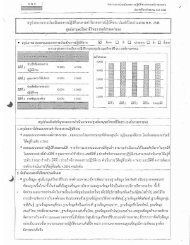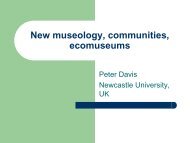Today, the photograph “Three Yakama Women” is a partof the Plateau Peoples’ Web Portal, an interactive, onlinedigital archive developed by Washington State Universityin 2008 to provide access to Plateau peoples’ culturalmaterials through collaboration with tribal communities.Members of five tribal nations have the ability to addand curate materials from their own tribes, therebyclaiming space for the voices of source communities andchallenging the widespread valorization of institutionalnarratives of objects and histories. “Three Yakama Women”is now presented in rich detail, enhanced with accountsof tribal knowledgefrom Yakama peoplewho are members ofthe web portal.The PlateauPeoples’ Web Portalwould not exist withoutthe free, open-sourcecommunity archive2“The workshop was part of the SAC’songoing Culture and Rights Forum,with interest in Mukurtu arising asresearchers continue to considerthe roles that source communitiesplay in database development anddissemination.”platform Mukurtu, which enables indigenous communitiesto access and circulate digital cultural heritage materials inways that reflect their own cultural priorities. Recognizingthe potential applicability of Mukurtu to its digital databaseprojects, the Princess Maha Chakri Sirindhorn AnthropologyCenter organized a Mukurtu workshop from the 17th to the18th of December 2012, and SAC staff had the opportunityto learn from and exchange with Dr. Kimberly Christen,Mukurtu Project Director, and Dr. Michael Ashley, MukurtuDevelopment Director. The workshop was part of the SAC’songoing Culture and Rights Forum, with interest in Mukurtuarising as researchers continue to consider the roles thatsource communities play in database development anddissemination.Digital technologies have become so embeddedin daily life that many individuals accustomed to thisseamless integration fail to question the hierarchy ofaccess that determines who can produce and engage withdevices, programs, and content. The Mukurtu programevolved from an effort to address and destabilize thesecategories that shape our understanding of and interactionwith digital platforms such as the internet. In 1995, whenmembers of a Warumungu community in Tennant Creek,Australia started building their own arts and culture center,they achieved the return of many local artifacts that hadbeen housed at national museums across Australia. Inaddition to these physical returns, the community alsoreceived over 700 digitized photographs that were takenby an early missionary to Tennant Creek. Most communitymembers had never seen the images, but upon assessingthe collection, they decided that many photos andthe knowledge surrounding them should not be madeuniversally accessible. Some images contained sacred orsensitive content that necessitated restricted viewership,with only certain kin,gender, or age groupsbeing permitted to seethe images and modifyor contribute relatedcontent.How could thisdigitized collection ofimages be featured atthe arts and culture center without sacrificing the “offline”cultural protocols that influence diffusion of knowledgeand reaffirm positionality and social order within thecommunity? Working alongside Warumungu communitymembers, Dr. Kim Christen began incorporating thesealready-existing community roles and relationshipsinto the digital platform that would become Mukurtu.Each photograph was classified with different levels ofcultural protocols to determine appropriate audience,such as, “restricted community: male AND bird clan.”Every community member has their own username andpassword, and their access level corresponds with theiruser profile, which is determined collectively and set bya system administrator. If a database user’s profile saysthat she is a female member of the snake clan, then thisperson will be able to see and contribute to all “open”content, as well as to all content that is restricted tofemales OR snake clan members, and finally, to all contentthat is restricted to females AND members of the snakeclan. In the Warumungu language, Mukurtu means “dillybag,” or a bag used to hold sacred items. The dilly bagis accessible to members who act responsibly withinthe community and gain the trust and permission ofknowledgeable community leaders. Like the dilly bag,
a Mukurtu-powered archive is a “safe keeping place,” acommunity repository for cultural materials and knowledgethat grows from sustained use, dialogue and negotiations(Mukurtu 2012).Over the course of the two-day workshop at theSAC, Dr. Christen and Dr. Ashley introduced Mukurtu’smain features and instructed SAC staff on how totechnically implement the platform. Although staff are stilldeciding if Mukurtu will beincorporated into any existingSAC databases, the Mukurtuworkshop was a catalystfor needed discussion andexchange. SAC researchersgave presentations ontheir respective projects,specifically highlightingproject target groups and processes of communityparticipation in management and utilization of data. Thepresentations provided valuable opportunities for staffto reflect upon the trajectories of their projects in thecontext of the SAC’s strategic objectives and the sourcecommunity-drivenethos of Mukurtu. In consideringthe SAC’s digital databases, Dr. Paritta ChalermpowKoanantakool, the former director of the SAC, calledfor increased “database dialogue,” or the fostering ofconnections and collaborations across databases andprojects. Before such dialogue can occur, however,target groups must be firmly delineated, which involvesconfronting the perceived dichotomy between academicsand source communities as target user groups. TheLocal Museums in Thailand team is currently grapplingwith this issue as they develop access options for theLocal Museums Database to enable museum staff andlocal community members to contribute and modifycontent. Similarly, the Anthropological Archives Databaseresearchers are creating a system of cultural protocols thatwill protect culturally sensitive content and allow sourcecommunity members to add their own narratives to thematerials gathered by anthropologists.“The availability of Mukurturepresents a crucial steptowards integrating therights and voices of sourcecommunities into all aspectsof heritage management”One concern that was raised by SAC staff, however, isthe suitability of digital platforms like Mukurtu in a localThai context. In communities where computer use is stillvery much determined by age and income, embodyingthe inequalities of the “digital divide,” staff fear thatthe introduction of Mukurtu could unintentionally resultin the creation of an exclusive community-within-acommunityof contributors, or individuals who already havecomputer skills and can attest to the relevance of digitaltechnologies to their daily lives.This inadvertent preferencingof voices would be difficultto avoid in communities withfew computers or computersavvymembers. Moreover,SAC staff worry that in suchcommunities, the desire toutilize a program like Mukurtuwould not emerge from within the community itself,but would instead be encouraged and imposed byresearchers, therefore undermining the researchers’and Mukurtu’s core goal of community ownership andempowerment.The Mukurtu Workshop helped to draw outand illuminate the challenges that face project staff indeveloping dynamic, inclusive, and sustainable digitaldatabases. As cultural heritage resources are increasinglydigitized and made accessible via the internet, practitionerseverywhere must consider how these rich accounts oftangible and intangible culture can be shared in ways thatrespect the rights and priorities of source communitiesand position community members as primary decisionmakers.References CitedMukurtu. “Manual: FAQ.” Last modified May 23, 2012. http://www.mukurtu.org/wiki/Manual:FAQ.The availability of Mukurtu represents a crucialstep towards integrating the rights and voices of sourcecommunities into all aspects of heritage management.3







